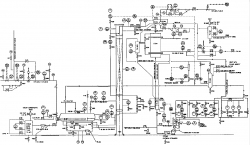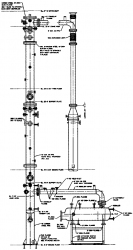Chemical and Process Engineering Resources
Distillation Pilot Plant Design, Operating Parameters and Scale-up Considerations
Dec 13 2010 11:53 AM | Chris HaslegoNorton Distillation Pilot Plants
Norton Chemical Process Products Corporation (NCPPC) and its predecessor company has been operating a carbon steel distillation pilot plant for over 30 years at NCPPC's Chamberlain Laboratories in Stow, Ohio. The internal diameter of the tower is 387 mm (15.25 in.) and it could accommodate beds up to 3050 mm (10 ft.) in depth.
In 1992, NCPPC designed and built a new high-pressure distillation pilot plant. This tower and its ancillary equipment were fabricated from 316L stainless steel. This tower can be operated from high vacuum (0.133 kPa = 1 mm Hg. Abs.) to 2170 kPa (300 psig) at 177°C. It can be operated at pressures up to 2860 kPa (400 psig) at lower temperatures. This tower, like the carbon steel distillation tower has an internal diameter of 387 mm (15.25 in.). It can accommodate packed beds up to 7000 mm (23 ft.) in depth, resulting in a height-to-diameter ratio up to 18.
 |
| Figure 1: Distillation Pilot Plant |
Both distillation pilot plants have similar flow schemes; they are located in a 12.2 m (40 ft.) tall high bay. The main difference is that the carbon steel distillation column sits atop a kettle reboiler, whereas the vapor produced in the stainless steel kettle reboiler enters the stainless steel distillation column through a 200 mm diameter side nozzle. A carbon steel skirt fastened to the floor supports the stainless steel column. Figure 1 shows the flow scheme of the stainless steel distillation tower, and Figure 2 is a scale drawing of the major pieces of equipment. Both columns can be operated at total reflux, or in the rectification mode at a LN ratio of less than 1. In addition, the high-pressure stainless steel tower has the capability to be modified as a center feed tower with beds up to 3050 mm (10 ft.) in the stripping as well as the rectification sections.
An important feature of the stainless steel tower is that it is provided with observation windows designed to withstand a pressure of 4236 kPa (600 psig) at 287°C. There are two pairs of windows in the vicinity of the reflux distributors and two pairs at the center feed location. One window of each pair is 100 mm in diameter used for illumination and the other window, which is perpendicular to the first, is 150 mm in diameter and is used for observation. The carbon steel distillation tower has three observation windows (150 mm diameter) in the vicinity of the reflux distributor. These observation windows permits the operator to observe the performance of the distributor, to look for any entrainment of liquid in the vapor and the onset of flooding. These windows have proved to be extremely valuable tools to characterize the distillation performance of the tower packings and distributors that have been tested over the years.
 |
| Figure 2: Elevation View of Pilot Plant |
In the design of both pilot plants particular attention has been paid to minimize the hold-up of liquid in the overhead condensate circuit, viz., condenser, condensate line, condensate tank and reflux line. Both pilot plants use vertical condensers with the vapor condensing in vertical tubes thus minimizing the hold-up of the overhead product. The reboilers of both pilot plants are just large enough to hold sufficient charge of liquid such that the increasing hold-up of liquid in the packing resulting from increasing boil-up does not drastically deplete the reboiler liquid of its light component. The carbon steel reboiler can hold up to 0.38 cubic meters (100 gallons) of liquid and the stainless steel reboiler can hold up to 0.57 cubic meters (150 gallons) of liquid.
The members of FRI and SRP have access to the test data generated in the respective test columns. FRI has the capability to run high vacuum to high-pressure systems and the SRP can run systems from high vacuum to 507 kPa (60 psig), but neither FRI nor SRP has the capability to run corrosive systems. FRI has 1213 mm (47.75 in.) and 2438 mm (8 ft.) I.D. column sections whereas the SRP tower has an I.D. of 429 mm (16.875 in.). As far as the authors are aware of, NCPPC's stainless steel distillation pilot plant is the only one that is capable of testing all commercial size packings from high vacuum to high pressure in both non-corrosive and corrosive systems.
We have tested all sixes of NCPPC random packings in one of the two pilot distillation units. The tower diameter-to-packing size ratio ranged from 5.5 to 26. This list includes all sizes of Intalox Metal Tower packings (IMTP packing), Pall rings, Hy-Pak packing and several other random packings. Furthermore, all sizes of NCPPC's Intalox structured packings viz.; 1T, 2T, 3T, 4T and 5T, were also tested in these pilot distillation columns.
Download a legacy print-ready version of this article with high-resolution versions of Figures 1 and 2

 FB
FB

0 Comments